Is One kind of Cutting Board REALLY better than another?
There is a lot of talk out there about what kind of cutting board is best to use. In fact, I get a lot of people asking me about the benefits of a wood cutting board when we sell them at fairs. I have heard every opinion out there and so I wanted to do my own research. Yes, I have my own experience, but I also have this tool called the internet that allows me to access research I would otherwise not have available. I really do try my best to make educated decisions based on some kind of research and I try to pick credible sources for that information. My references are all sited at the end, but here is the basics.
This is my cutting board selection:

As you see I currently have a variety of options. My favorite by far are my wood cutting boards but all have their own advantages. We will talk about those but after my research I think my cutting board selection will be changing some.
A note on germs…

I am not a germaphobe. Granted, when my son was 2 and he licked a wall at the checkout stand from top to bottom I about freaked. Then I shared the story with some Mom friends and mine was by far the tamest story and all of our kids were alive and well.
There are germs and bacteria everywhere. The body doesn’t function well if all are eliminated. There is necessary and beneficial bacteria all around us.
Reference.com states it simply (though you can find many reliable references for the same information) ” Though some bacterias cause disease and illness in humans, the majority are harmless. Some bacterias are used to aid digestion, used in preparation of certain foods, used to battle infections or used by industry.” I mean who doesn’t love cheese and sausage? Right? Granted, I still get the hebbie geebbies when I am shown microscopic pictures of them in my water and on my body and have a temporary urge to scrub everything with bleach… but science tells us to relax and take a deep breath.
The real concern we are addressing here is:
Are our cutting boards harboring bacteria in a way that is harmful for our families? What can we do to reduce that risk? And does the type of cutting board we use make a difference?
Below the pros and cons I have referenced my resources so if you want to follow through with the same research yourself you can. I found the best resource to be this article to be this research by Dean O. Cliver, Ph.D. I feel no need to restate all of their facts, but here are the pros and cons I have found for each with a little detail.
What Cutting Board Material is Best?
WOOD CUTTING BOARDS

PROS:
Wood cutting boards harbor less bacteria than plastic
- Dean O. Cliver, PhD from University of California, Davis, conducted research on the subject and found that wood cutting boards contained less salmonella bacteria than plastic. On wood cutting boards, the bacteria sank “down beneath the surface of the cutting board, where they didn’t multiply and eventually died off.”
Wood cutting boards can be resurfaced easily
- FDA’s official opinion is that both wood and plastic are safe so long as they’re cleaned well and replaced once they develop deep hard to clean grooves.
- Wood cutting boards (boards made from a hard wood, not bamboo) can be sanded and then refinished with food-safe mineral oil. This eliminates the need to completely replace a wood cutting board.
Wood has a warmth that plastic doesn’t
- Yes, I know this has nothing to do with germs, but the feel of wood is wonderful. When we are at fairs selling cutting boards people always feel compelled to touch them. When do you feel compelled to touch a plastic cutting board? Me. Never. I would imagine that this is also the reason that Recycled Plastic Furniture isn’t as popular as a piece of regular furniture, it doesn’t really have that “home” feel!
Cons
- Many organizations believe that wood is unsafe so, in many places you can only use plastic
- Wood Cutting boards require hand washing. Do not put a wood cutting board in the dishwasher. Cutting boards must be hand washed directly after use with a mild detergent and warm water and then allowed to dry to prevent bacteria from growing. Soaking in water can cause swelling of the wood and will cause any glue holding them together to break down.
- Wood cutting boards are typically heavier than the other choices.
PLASTIC CUTTING BOARDS
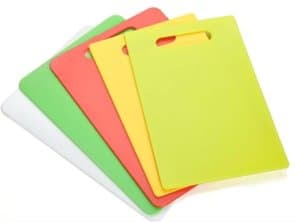
Pros:
Easy to clean
- Many throw their plastic cutting boards in the dishwasher to clean them. Though this is easy to do, unless you have a sanitizing cycle you put them through at the end you run the risk of simply throwing that potentially harmful bacteria all over everything else in the dishwasher.
- NEW Plastic boards are easily cleaned. Cliver states”New plastic surfaces allowed the bacteria to persist, but were easily cleaned and disinfected.” See Cons for important note on USED plastic cutting boards
Cheap to purchase
- You can find Plastic cutting boards in sets of of 4 for less than $15. A good hardwood cutting board will cost $25 or more depending on size. However, this is where you come to ask yourself… If I have to replace this cutting board for safety every time it gets grooves cut into it (see cons below) am I really saving money? And money is not the only cost to consider if you have to keep putting them in the trash.
Cons
The Game Changer:
Used Plastic boards with knife- scarring can harbor bacteria. Even after a good cleaning. 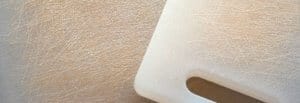
- The FDA recommends that all used/ knife-scarred boards be replaced because these cuts can harbor harmful bacteria. Clivers research also supports this fact. NOTE: New Cutting boards do not have this issue. Clivers notes in his article that much research disputing this fact used only new plastic boards.
- It is also clearly stated in the research that running a used cutting board through a dishwasher will not penetrate the cracks in a plastic cutting board. I know, bummer right?! I love my well loved plastic cutting board. However, after discovering this scientifically backed info our white, beat up plastic cutting board was relegated to the craft drawer.
GLASS CUTTING BOARDS
I didn’t research glass cutting boards for this post for a couple reasons. First, glass cutting boards dull your knives. This was a deal breaker for me. After I found this to be true from my own experience My glass cutting board now stays in a different location and is used for other things other than cutting food. Secondly, I also don’t like the feel of it or the horrible sound the knife makes as it cuts on the glass. It was like nails on a chalkboard for me. Lastly, The research made from the wood and plastic cutting boards study can easily be applied to glass cutting boards.
Conclusions….Wood or Plastic…

First of all, as you can see from the picture I have a lot of cutting boards. I don’t keep one board for meat and another for veggies. Even if I did, realistically the kids are gonna mess up that system. I promptly wash any board used for meat during food preparation and another board is used for veggies.
After my research I came to a couple conclusions…
- BOTH plastic and wood cutting boards can harbor harmful bacteria if not properly cared for. All cutting boards need to be promptly washed all right after use.
- The much loved plastic cutting boards are being regulated to the craft area.
- We need to continue the practice of limiting cross-contamination by using different cutting boards when prepping meat. I don’t have a sole “meat prepping” cutting board but all long as I keep them properly cleaned than that isn’t an issue.
- Wood cutting boards are definitely the way to go (and if you don’t have them, then you’ll be pleased to know that you can find cutting boards for sale here). This is what sold me on it… “we found that disease bacteria such as these were not recoverable from wooden surfaces in a short time after they were applied, unless very large numbers were used….New plastic surfaces allowed the bacteria to persist, but were easily cleaned and disinfected. However, wooden boards that had been used and had many knife cuts acted almost the same as new wood, whereas plastic surfaces that were knife-scarred were impossible to clean and disinfect manually, especially when food residues such as chicken fat were present. Scanning electron micrographs revealed highly significant damage to plastic surfaces from knife cuts”
If part of you has doubts because we sell wooden cutting boards…Here are the articles and research for you to explore for yourself:
Come and check out our Hardwood Maple Cutting Boards Here
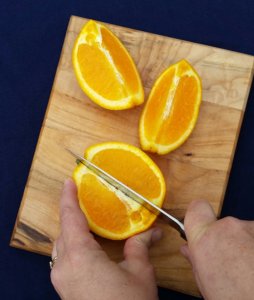
Small Maple Wood Cutting Board
Tampers, Mallets, Rolling Pins and more….
Happy Cooking,
The Frabjus Lady

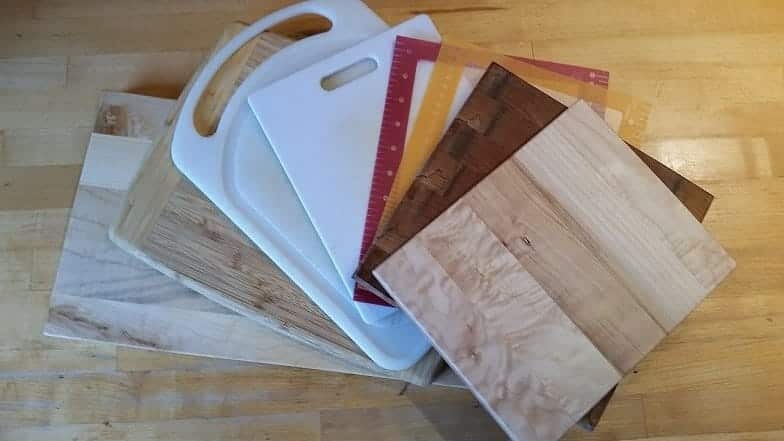
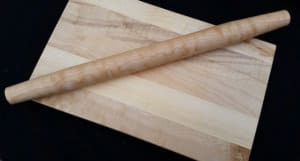
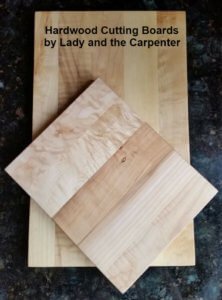
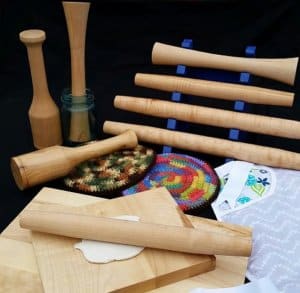

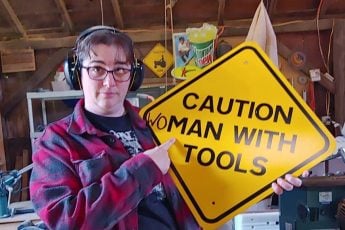

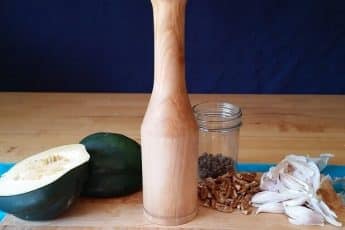
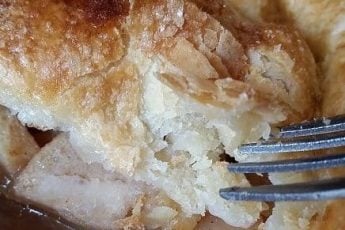
Gentle Joy Photography
March 16, 2017 1:18 amGreat post…. I have heard some of this before and yet, this was nicely put in a format that makes it very easy to see the benefits and problems with each. Thank you.